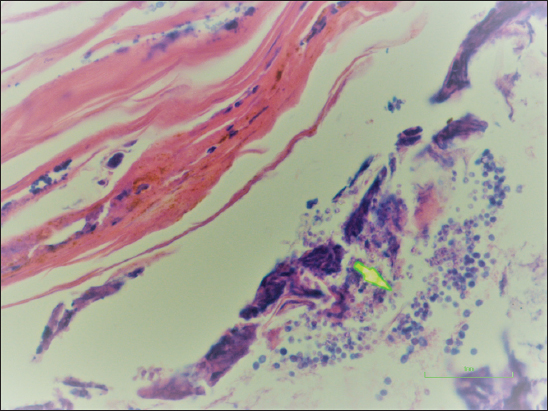Comment to:
Erythroderma due to iatrogenic immunosuppression: A case of Norwegian scabies
Hubert Daisley Jr , Arlene Rampersad, Oneka Acco
, Arlene Rampersad, Oneka Acco
Department of Pathology, General Hospital San Fernando, San Fernando, Trinidad, West Indies
Corresponding author: Prof. Hubert Daisley Jr., E-mail: profhdjr@aol.com
Submission: 07.01.2019; Acceptance: 16.02.2019
DOI:10.7241/ourd.20192.26
Cite this article: Daisley Jr. H, Rampersad A, Acco O. Comment to: Erythroderma due to iatrogenic immunosuppression: A case of Norwegian scabies. Our Dermatol Online. 2019;10(2):202-203.
Citation tools:
BibTex | CSV | RIS | refer/BiblX | Endnote XML | Wikipedia Citation Templates
Copyright information
© Our Dermatology Online 2019. No commercial re-use. See rights and permissions. Published by Our Dermatology Online.
Sir,
We have read with interest the manuscript “Erythroderma due to iatrogenic immunosuppression: A case of Norwegian scabies” [1]. Such iatrogenic cases of crusted scabies are often seen where there is prolonged unsupervised use of steroids.
We had a similar case occurring in a 62-year-old female who suffered with rheumatoid arthritis and was treated with oral prednisolone. She defaulted from the medical clinic and continued self-medication with prednisolone for years. She developed a pruritic-generalized rash, which she treated with piriton and calamine lotion. This patient presented to the Accident and Emergency department in hypovolemic shock after several episodes of hematemesis and died shortly after presentation.
At autopsy a generalized crusted, and in some areas vesicular and erytheramotus rash covered her limbs, neck, chest, abdomen and back. A penetrating peptic ulcer was seen and the stomach and the rest of the gastrointestinal tract were filled with blood. A post-mortem biopsy of the crusted lesion showed sarcoptes scabiei eggs and scybala [2] within the stratum corneum (Fig. 1).
Norwegian Scabies is sequela of immunosuppression, and physicians should search for the underlying causes in each case. Patients with identifiable immunosuppressive risk factors such as organ transplantation, HIV and HTLV-1infections, hematological malignancies and those patients with prolonged steroid use and other immunosuppressive agents are but a few who are prone to contract Norwegian Scabies [3–6]. Prolonged steroid usage also has other complications including peptic/gastric ulcers thus physicians should be mindful of its side effects and educate patients of its usage.
Consent
The examination of the patient was conducted according to the Declaration of Helsinki principles.
REFERENCES
1. Adil M, Amin SS, Mohtashim M, Mushtaq S, Qadri S, Varshney I. Erythroderma due to iatrogenic immunosuppression:a case of Norwegian scabies. Our Dermatol Online. 2019;10:53-5.
2. Gary Fox. Diagnosis of scabies by dermoscopy. BMJ Case Rep. 2009;2009. pii:bcr06.2008.0279.
3. Ericson-Neilsen W, Kaye AD. Steroids:pharmacology, complications, and practice delivery issues. Ochsner J. 2014;14:203-7.
4. Bhat SA, Mounsey KE, Liu X, Walton SF. Host immune responses to the itch mite, Sarcoptes scabies, in humans. Parasit Vectors. 2017;10:385.
5. Daisley H, Charles W, Suite M. Crusted (Norwegian) Scabies as a Pre-Diagnostic Indicator for HTLV-1 Infection.? Trans R Soc Trop Med Hyg. 1993;87:295.
6. Roberts LJ, Huffam SE, Walton SF, Currie BJ. Crusted scabies:clinical and immunological findings in seventy-eight patients and a review of the literature. J Infect. 2005;50:375-81.
Notes
Source of Support: Nil
Conflict of Interest: None declared.
Request permissions
If you wish to reuse any or all of this article please use the e-mail (brzezoo77@yahoo.com) to contact with publisher.
| Related Articles | Search Authors in |
|
 http://orcid.org/0000-0002-7337-8050 http://orcid.org/0000-0002-7337-8050
|



Comments are closed.